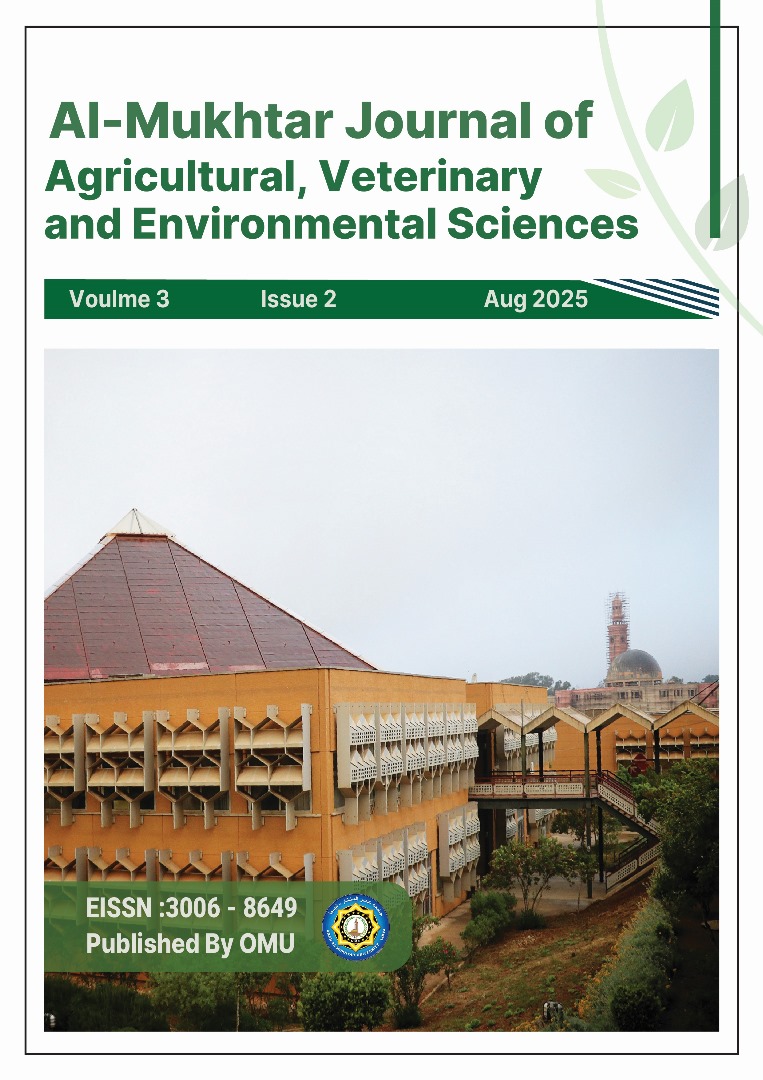The Allelopathic Effects of Aqueous Extracts from Vachellia nilotica On the Germination and development of Citrullus lanatus L
DOI:
https://doi.org/10.54172/53z2y290Keywords:
Allelopathy; plumule and radicle length; Sustainable Agriculture; acacia tree.Abstract
This study aims to evaluate the allelopathic effect of leaf extracts from the thorny acacia tree (Vachellia nilotica) on the germination and seedling growth of watermelon (Citrullus lanatus L). The experiment was conducted using three different concentrations of the aqueous extract of acacia leaves extract which are (0%, 20%, 40%, or 60%), in addition to a control group treated with distilled water. The effects of these extracts were assessed by measuring the parameters of Germination percentage, plumule and radicle length, seedling dry weight, and imbibition percentage. The results showed that the extracts at 40% and 60% concentrations enhanced the imbibition percentage compared to the control group, while for these concentrations (20%, and 60%) has no significant effect on the germination rate. Lower concentrations (20% and 40%) significantly stimulated plumule growth, whereas the highest concentration (60%) resulted in a reduction in plumule and radicle length. Moreover, the 60% concentration exhibited an inhibitory effect on radicle root growth, suggesting that the plant extracts may contain allelopathic compounds that influence seedling development. These findings confirm that the allelopathic effect of V. nilotica extracts is concentration-dependent (what are the allelopathic active compounds of V. nilotica), with a stimulatory effect at low doses and an inhibitory effect at higher doses. Further studies are needed to understand the mechanisms of allelopathic influence and its potential applications in mixed agricultural systems.
References
Abdulhussein, T. M. (2016). Effect of Water Extracts of Some Medicinal Plants on Germination Percentage and Development of Plumule and Radicle Growth Anethum graveolens L. Ibn Al-Haitham Journal for Pure and Applied Sciences, 29(3), 395-303.
Abrahim, D., Braguini, W. L. Kelmer-Bracht, A. M., & Ishii-Iwamoto, E. L. (2000). Effects of four monoterpenes on germination, primary root growth, and mitochondrial respiration of maize. Journal of Chemical Ecology, 26, 611–624.
Abu-Romman, S. (2016). Differential allelopathic expression of different plant parts of Achillea biebersteinii. Acta Biologica Hungarica, 67(2), 159-168.
Ahsyee, R., Abu Zakhar, F., & Marqab, S. (2021). Allelopathic effect of some aqueous plant ex-tracts and pesticides on germination and seedling vigor of barley (Hordeum vulgare L.). Jour-nal of Pure & Applied Sciences, 20(4), 202–205.
Alshareef, B. B., & Alaib, M. A. (2018). Investigation of allelopathic potential of Acacia nilotica L. The Third International Conference on Basic Sciences and Their Applications.
Alshareef, B. B., & M. A. A. (2019). Investigation of allelopathic potential of Acacia nilotica. EPH - International Journal of Applied Science, 5(1), 24–29.
Al-Wakeel, S., Gabr, M., Hamid, A., & Abu El-Soud, W. (2007). Allelopathic effects of Acacia nilotica leaf residue on Pisum sativum L. Allelopathy Journal, 19(2), 411.
Appleton, B., Harris, R., Alleman, D., & Swanson, L. (2000). Trees for problem landscape sites – The walnut tree: Allelopathic effects and tolerant plants. Virginia Cooperative Extension, Publication Number: 430-021.
Djurdjevic, L., Dinic, A., Pavlovic, P., Mitrovic, M., Karadzic, B., & Tesevic, V. (2004). Allelopa-thic potential of Allium ursinum L. Biochemical Systematics and Ecology, 32, 533–544.
Idan, B., A & Hussain W, S. (2022). Effect of Aqueous Extracts of Pumpkin Leaves and Vita-min B12 on some Growth and Physiological Characteristics of Types of Legumes. Al-Mukhtar Journal of Sciences, 37(3), 308–297.
Javaid, A., & Shah, M. B. M. (2007). Phytotoxic effects of aqueous leaf extracts of two Eucalyp-tus spp. against Parthenium hysterophorus L. Scientific International (Lahore), 19(4), 303-306.
Khan, M. A., Marwat, K. B., Hassan, G., & Hussain, Z. (2005). Bioherbicidal effects of tree ex-tracts on seed germination and growth of crops and weeds. Pakistan Journal of Weed Science Research, 11(3-4), 179-184.
Kluthe, B., Ali, M., & Stephenson, S. (2018). Allelopathic influence of Eucalyptus on common Kenyan agricultural crops. Journal of Agronomy and Agricultural Sciences, 1(1), 2-6.
Kumari, N., Srivastava, P., Mehta, S., & Das, B. (2016). Allelopathic effects of some promising agroforestry tree species on different annual crops. Ecology, Environment and Conservation, 22(1), 225-236.
Masoud, M., Omar, A. K., & Abugarsa, S. (2022). Allelopathic effects of aqueous extract from Satureja thymbra L. on seed germination and seedling growth of Pinus halepensis Mill. and Ceratonia siliqua L. Libyan Journal of Science & Technology, 7(1).
Mehmood, K., Asif, H. M., Bajwa, R. B., Shafique, S., & Shafique, S. (2011). Phytotoxic potential of bark extracts of Acacia nilotica and Syzygium cumini against Parthenium hysterophorus. Pakistan Journal of Botany, 43(6), 3007-3012.
Mohamed Bogelil, Omar. M. A. K., & Mohammed. H. (2024). The allelopathic effects of aqueous extracts from Pinus halepensis Mil. on the germination and development of red watermelon (Citrullus lanatus L.) seeds. Journal of Total Science, 9(34), 2518-5799.
Murray, D. R., Peoples, M. B., & Waters, S. P. (1979). Proteolysis in the axis of the germinating pea seed: I. Changes in protein-degrading enzyme activities of the radicle and primary root. Planta, 147, 111-116.
Othman, B., Haddad, D., & Tabbache, S. (2018). Allelopathic effects of Sorghum halepense (L.) Pers. and Avena sterilis L. water extracts on early seedling growth of Portulaca oleracea L. and Medicago sativa L. International Journal of Medical Science, 5(10), 7-12.
Reigosa, M. J., Souto, X. C., & Gonzalez, L. (1999). Effect of phenolic compounds on the germi-nation of weed species. Plant Growth Regulation, 28, 83-88.
Saeed, H. S., Rasul, F. S. M., Mubeen, M., & Nasim, W. (2013). Allelopathic potential assessment of Syzygium cumini L. on wheat. International Poster Journal of Science & Technology, 3(1), 09-14.
Saleha, M., Hawad, A., Alam, M., & Ali, A. (2018). Preliminary qualitative phytochemical analy-sis of Acacia nilotica fruits collected from Majdool Town, Southern of Libya. Journal of Pure & Applied Sciences, 17(1).
Saxena, A. (1996). Allelopathic potential of Acacia tortilis in agroforestry systems of arid re-gions. Allelopathy Journal, 3, 81-84.
Seigler, D. S. (2003). Phytochemistry of Acacia – sensu lato. Biochemical Systematics and Ecolo-gy, 31, 845-873.
Tripathi, S., Tripathi, A., Kori, D. C., & Tiwari, S. (1998). Effect of tree leaves aqueous extracts on germination and seedlings growth of soybean. Allelopathy Journal, 5(1), 75-82.
Yanar, Y., & Kadioglu, I. (2004). Allelopathic effects of plant extracts against seed germination of some weeds. Asian Journal of Plant Sciences, 3(4), 472-475.
Yousif, M. A. I., Wang, Y. R., & Dali, C. (2020). Seed dormancy overcoming and seed coat struc-ture change in Leucaena leucocephala and Acacia nilotica. Forest Science and Technology, 16(1), 18-25.
Downloads
Published
Issue
Section
License

This work is licensed under a Creative Commons Attribution-NonCommercial 4.0 International License.













